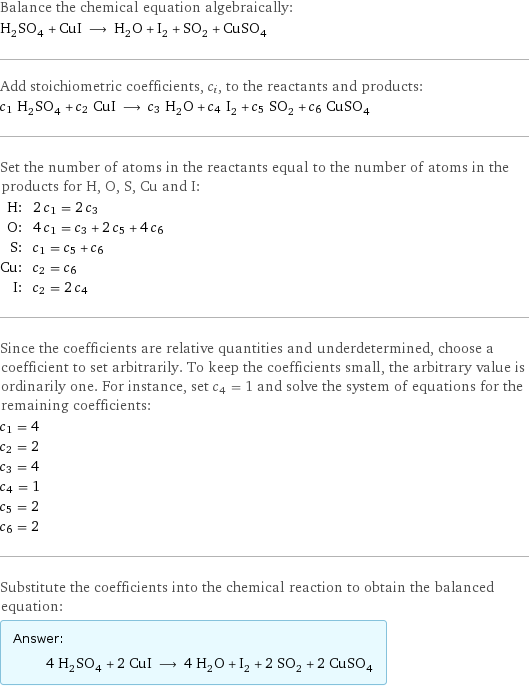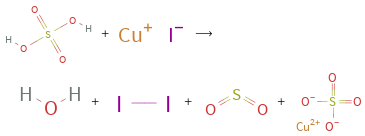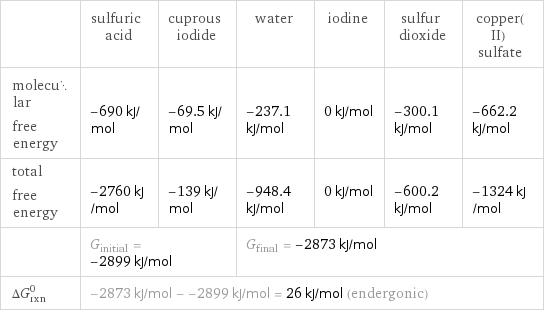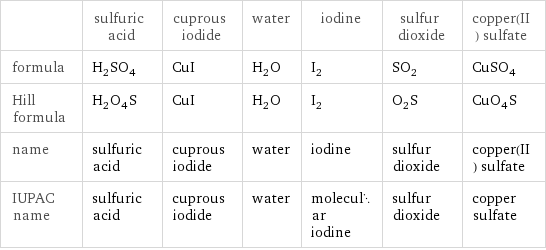Input interpretation

H_2SO_4 sulfuric acid + CuI cuprous iodide ⟶ H_2O water + I_2 iodine + SO_2 sulfur dioxide + CuSO_4 copper(II) sulfate
Balanced equation

Balance the chemical equation algebraically: H_2SO_4 + CuI ⟶ H_2O + I_2 + SO_2 + CuSO_4 Add stoichiometric coefficients, c_i, to the reactants and products: c_1 H_2SO_4 + c_2 CuI ⟶ c_3 H_2O + c_4 I_2 + c_5 SO_2 + c_6 CuSO_4 Set the number of atoms in the reactants equal to the number of atoms in the products for H, O, S, Cu and I: H: | 2 c_1 = 2 c_3 O: | 4 c_1 = c_3 + 2 c_5 + 4 c_6 S: | c_1 = c_5 + c_6 Cu: | c_2 = c_6 I: | c_2 = 2 c_4 Since the coefficients are relative quantities and underdetermined, choose a coefficient to set arbitrarily. To keep the coefficients small, the arbitrary value is ordinarily one. For instance, set c_4 = 1 and solve the system of equations for the remaining coefficients: c_1 = 4 c_2 = 2 c_3 = 4 c_4 = 1 c_5 = 2 c_6 = 2 Substitute the coefficients into the chemical reaction to obtain the balanced equation: Answer: | | 4 H_2SO_4 + 2 CuI ⟶ 4 H_2O + I_2 + 2 SO_2 + 2 CuSO_4
Structures

+ ⟶ + + +
Names

sulfuric acid + cuprous iodide ⟶ water + iodine + sulfur dioxide + copper(II) sulfate
Reaction thermodynamics
Enthalpy

| sulfuric acid | cuprous iodide | water | iodine | sulfur dioxide | copper(II) sulfate molecular enthalpy | -814 kJ/mol | -67.8 kJ/mol | -285.8 kJ/mol | 0 kJ/mol | -296.8 kJ/mol | -771.4 kJ/mol total enthalpy | -3256 kJ/mol | -135.6 kJ/mol | -1143 kJ/mol | 0 kJ/mol | -593.6 kJ/mol | -1543 kJ/mol | H_initial = -3392 kJ/mol | | H_final = -3280 kJ/mol | | | ΔH_rxn^0 | -3280 kJ/mol - -3392 kJ/mol = 111.9 kJ/mol (endothermic) | | | | |
Gibbs free energy

| sulfuric acid | cuprous iodide | water | iodine | sulfur dioxide | copper(II) sulfate molecular free energy | -690 kJ/mol | -69.5 kJ/mol | -237.1 kJ/mol | 0 kJ/mol | -300.1 kJ/mol | -662.2 kJ/mol total free energy | -2760 kJ/mol | -139 kJ/mol | -948.4 kJ/mol | 0 kJ/mol | -600.2 kJ/mol | -1324 kJ/mol | G_initial = -2899 kJ/mol | | G_final = -2873 kJ/mol | | | ΔG_rxn^0 | -2873 kJ/mol - -2899 kJ/mol = 26 kJ/mol (endergonic) | | | | |
Equilibrium constant
![Construct the equilibrium constant, K, expression for: H_2SO_4 + CuI ⟶ H_2O + I_2 + SO_2 + CuSO_4 Plan: • Balance the chemical equation. • Determine the stoichiometric numbers. • Assemble the activity expression for each chemical species. • Use the activity expressions to build the equilibrium constant expression. Write the balanced chemical equation: 4 H_2SO_4 + 2 CuI ⟶ 4 H_2O + I_2 + 2 SO_2 + 2 CuSO_4 Assign stoichiometric numbers, ν_i, using the stoichiometric coefficients, c_i, from the balanced chemical equation in the following manner: ν_i = -c_i for reactants and ν_i = c_i for products: chemical species | c_i | ν_i H_2SO_4 | 4 | -4 CuI | 2 | -2 H_2O | 4 | 4 I_2 | 1 | 1 SO_2 | 2 | 2 CuSO_4 | 2 | 2 Assemble the activity expressions accounting for the state of matter and ν_i: chemical species | c_i | ν_i | activity expression H_2SO_4 | 4 | -4 | ([H2SO4])^(-4) CuI | 2 | -2 | ([CuI])^(-2) H_2O | 4 | 4 | ([H2O])^4 I_2 | 1 | 1 | [I2] SO_2 | 2 | 2 | ([SO2])^2 CuSO_4 | 2 | 2 | ([CuSO4])^2 The equilibrium constant symbol in the concentration basis is: K_c Mulitply the activity expressions to arrive at the K_c expression: Answer: | | K_c = ([H2SO4])^(-4) ([CuI])^(-2) ([H2O])^4 [I2] ([SO2])^2 ([CuSO4])^2 = (([H2O])^4 [I2] ([SO2])^2 ([CuSO4])^2)/(([H2SO4])^4 ([CuI])^2)](../image_source/2f39133e4da3ee749cfbae097dd99643.png)
Construct the equilibrium constant, K, expression for: H_2SO_4 + CuI ⟶ H_2O + I_2 + SO_2 + CuSO_4 Plan: • Balance the chemical equation. • Determine the stoichiometric numbers. • Assemble the activity expression for each chemical species. • Use the activity expressions to build the equilibrium constant expression. Write the balanced chemical equation: 4 H_2SO_4 + 2 CuI ⟶ 4 H_2O + I_2 + 2 SO_2 + 2 CuSO_4 Assign stoichiometric numbers, ν_i, using the stoichiometric coefficients, c_i, from the balanced chemical equation in the following manner: ν_i = -c_i for reactants and ν_i = c_i for products: chemical species | c_i | ν_i H_2SO_4 | 4 | -4 CuI | 2 | -2 H_2O | 4 | 4 I_2 | 1 | 1 SO_2 | 2 | 2 CuSO_4 | 2 | 2 Assemble the activity expressions accounting for the state of matter and ν_i: chemical species | c_i | ν_i | activity expression H_2SO_4 | 4 | -4 | ([H2SO4])^(-4) CuI | 2 | -2 | ([CuI])^(-2) H_2O | 4 | 4 | ([H2O])^4 I_2 | 1 | 1 | [I2] SO_2 | 2 | 2 | ([SO2])^2 CuSO_4 | 2 | 2 | ([CuSO4])^2 The equilibrium constant symbol in the concentration basis is: K_c Mulitply the activity expressions to arrive at the K_c expression: Answer: | | K_c = ([H2SO4])^(-4) ([CuI])^(-2) ([H2O])^4 [I2] ([SO2])^2 ([CuSO4])^2 = (([H2O])^4 [I2] ([SO2])^2 ([CuSO4])^2)/(([H2SO4])^4 ([CuI])^2)
Rate of reaction
![Construct the rate of reaction expression for: H_2SO_4 + CuI ⟶ H_2O + I_2 + SO_2 + CuSO_4 Plan: • Balance the chemical equation. • Determine the stoichiometric numbers. • Assemble the rate term for each chemical species. • Write the rate of reaction expression. Write the balanced chemical equation: 4 H_2SO_4 + 2 CuI ⟶ 4 H_2O + I_2 + 2 SO_2 + 2 CuSO_4 Assign stoichiometric numbers, ν_i, using the stoichiometric coefficients, c_i, from the balanced chemical equation in the following manner: ν_i = -c_i for reactants and ν_i = c_i for products: chemical species | c_i | ν_i H_2SO_4 | 4 | -4 CuI | 2 | -2 H_2O | 4 | 4 I_2 | 1 | 1 SO_2 | 2 | 2 CuSO_4 | 2 | 2 The rate term for each chemical species, B_i, is 1/ν_i(Δ[B_i])/(Δt) where [B_i] is the amount concentration and t is time: chemical species | c_i | ν_i | rate term H_2SO_4 | 4 | -4 | -1/4 (Δ[H2SO4])/(Δt) CuI | 2 | -2 | -1/2 (Δ[CuI])/(Δt) H_2O | 4 | 4 | 1/4 (Δ[H2O])/(Δt) I_2 | 1 | 1 | (Δ[I2])/(Δt) SO_2 | 2 | 2 | 1/2 (Δ[SO2])/(Δt) CuSO_4 | 2 | 2 | 1/2 (Δ[CuSO4])/(Δt) (for infinitesimal rate of change, replace Δ with d) Set the rate terms equal to each other to arrive at the rate expression: Answer: | | rate = -1/4 (Δ[H2SO4])/(Δt) = -1/2 (Δ[CuI])/(Δt) = 1/4 (Δ[H2O])/(Δt) = (Δ[I2])/(Δt) = 1/2 (Δ[SO2])/(Δt) = 1/2 (Δ[CuSO4])/(Δt) (assuming constant volume and no accumulation of intermediates or side products)](../image_source/5f73678f59bb7e5489df834b5e66665a.png)
Construct the rate of reaction expression for: H_2SO_4 + CuI ⟶ H_2O + I_2 + SO_2 + CuSO_4 Plan: • Balance the chemical equation. • Determine the stoichiometric numbers. • Assemble the rate term for each chemical species. • Write the rate of reaction expression. Write the balanced chemical equation: 4 H_2SO_4 + 2 CuI ⟶ 4 H_2O + I_2 + 2 SO_2 + 2 CuSO_4 Assign stoichiometric numbers, ν_i, using the stoichiometric coefficients, c_i, from the balanced chemical equation in the following manner: ν_i = -c_i for reactants and ν_i = c_i for products: chemical species | c_i | ν_i H_2SO_4 | 4 | -4 CuI | 2 | -2 H_2O | 4 | 4 I_2 | 1 | 1 SO_2 | 2 | 2 CuSO_4 | 2 | 2 The rate term for each chemical species, B_i, is 1/ν_i(Δ[B_i])/(Δt) where [B_i] is the amount concentration and t is time: chemical species | c_i | ν_i | rate term H_2SO_4 | 4 | -4 | -1/4 (Δ[H2SO4])/(Δt) CuI | 2 | -2 | -1/2 (Δ[CuI])/(Δt) H_2O | 4 | 4 | 1/4 (Δ[H2O])/(Δt) I_2 | 1 | 1 | (Δ[I2])/(Δt) SO_2 | 2 | 2 | 1/2 (Δ[SO2])/(Δt) CuSO_4 | 2 | 2 | 1/2 (Δ[CuSO4])/(Δt) (for infinitesimal rate of change, replace Δ with d) Set the rate terms equal to each other to arrive at the rate expression: Answer: | | rate = -1/4 (Δ[H2SO4])/(Δt) = -1/2 (Δ[CuI])/(Δt) = 1/4 (Δ[H2O])/(Δt) = (Δ[I2])/(Δt) = 1/2 (Δ[SO2])/(Δt) = 1/2 (Δ[CuSO4])/(Δt) (assuming constant volume and no accumulation of intermediates or side products)
Chemical names and formulas

| sulfuric acid | cuprous iodide | water | iodine | sulfur dioxide | copper(II) sulfate formula | H_2SO_4 | CuI | H_2O | I_2 | SO_2 | CuSO_4 Hill formula | H_2O_4S | CuI | H_2O | I_2 | O_2S | CuO_4S name | sulfuric acid | cuprous iodide | water | iodine | sulfur dioxide | copper(II) sulfate IUPAC name | sulfuric acid | cuprous iodide | water | molecular iodine | sulfur dioxide | copper sulfate